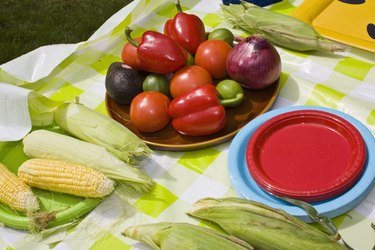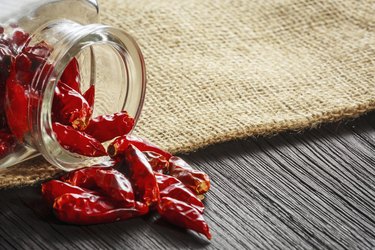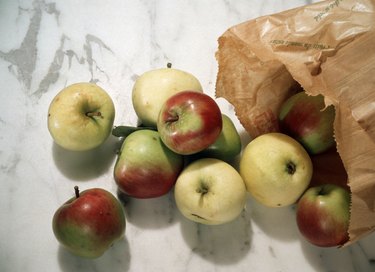
Glucose and fructose are the simplest forms of sugar that can be absorbed into the bloodstream. These sugars are naturally present in foods such as grains, fruits and vegetables. They are also the major ingredients in many sweeteners and processed foods. If you have fructose intolerance, you need to avoid foods with high fructose content. In a recent review published in "Nutrition," researchers at the University of Lausanne in Switzerland said that when fructose is consumed in excessive amounts as part of a high calorie diet, it can contribute to development of metabolic syndrome, a major risk factor for diabetes and heart disease. However, over-consumption of fructose and glucose from eating lots of fresh fruits and vegetables is not likely.
Vegetables
Video of the Day

Fresh vegetables naturally contain minimal glucose and fructose. Unprocessed vegetables have a range of fructose and glucose content between 0.1 g and 1.5 g per 100 g portion. Fresh broccoli and avocado have the lowest amounts, with about 0.1 g glucose and fructose in 100 g. White cabbage has 1.5 g fructose and 1.9 g glucose when boiled. Although chili pepper contains about 2.3 g fructose, the amount used is usually well under 100 g.
Video of the Day
Fruits

Fruits have a higher fructose content than vegetables. Fresh fruits have a range of fructose and glucose content between 0.5 g and 9.5 g per 100 g portion. Lime has 0.5 g fructose and glucose; grapefruit contains 1.8 g fructose and glucose; grapes contain 9.5 g fructose and 7.1 g glucose. For those with fructose intolerance, Food Intolerance Diagnostics in Australia suggests that it is more helpful to look at the fructose to glucose ratio, because foods are better tolerated when they have equal amount of glucose and fructose. Fruits with a fructose content of 3 g or more per serving should be limited. Examples are apple, cherry, melons, orange, papaya, pear, persimmon and pineapple.
Processed Fruits and Vegetables

Dried, canned and commercially processed fruits and vegetables contain much higher amount of fructose and glucose that come from the use of sweeteners and preservatives such as high fructose corn syrup. Dried fruits average about 30 g fructose and glucose per 100 g portion, while canned and commercially processed fruits contain between 6 and 12 g fructose and glucose.
Considerations
While it is prudent for people with fructose intolerance to limit or avoid certain foods, most may want to focus on limiting processed foods with added sweeteners because such foods may also increase cholesterol levels. In a study published in the "Journal of Clinical Endocrinology Metabolism," researchers at the University of California, Davis, found that when participants consumed high doses of fructose, at 25 percent or more of total energy intake, apo B, a bad type of cholesterol, increased significantly in two weeks compared to those who consumed glucose.
- "Nutrition"; Fructose and Metabolic Diseases: New Findings, New Questions; Luc Tappy, et al.; November 2010
- Food Intolerance Diagnostics: Food Tables Fructose
- "Journal of Clinical Endocrinology Metabolism"; Consumption of Fructose and High Fructose Corn Syrup Increase Postprandial Triglycerides, LDL-Cholesterol, and Apolipoprotein-B in Young Men and Women; Kimber Stanhope, et al.; August 2011
Is this an emergency? If you are experiencing serious medical symptoms, please see the National Library of Medicine’s list of signs you need emergency medical attention or call 911.